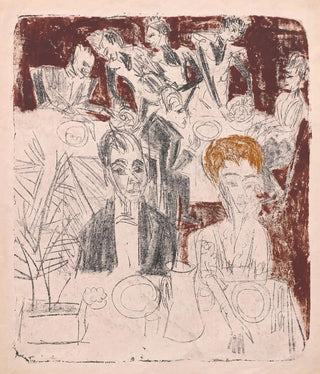Art print | At the table - Ernst Ludwig Kirchner


View from behind

Frame (optional)
Art print À table - Ernst Ludwig Kirchner – Engaging introduction
In the vibrant world of modern art, the work "À table" by Ernst Ludwig Kirchner stands out for its ability to capture the very essence of social life in the early 20th century. This painting, full of color and emotion, invites the viewer to immerse themselves in a scene of conviviality, where the intimacy of the characters blends with a sense of anxiety characteristic of the era. Kirchner, a founding member of the Expressionist group Die Brücke, uses his art to explore the complexities of human existence, and "À table" is a perfect example. The scene depicts figures gathered around a table, symbolizing both the warmth of human relationships and the alienation felt in the emerging modernity.
Style and uniqueness of the work
Kirchner's style is immediately recognizable, characterized by bold lines and saturated colors that seem to vibrate on the canvas. In "À table," the artist employs a palette of bright hues that evoke an atmosphere both festive and unsettling. The characters, with distorted proportions, reflect the intensity of human emotions, oscillating between joy and melancholy. Kirchner does not merely depict a scene of life; he extracts its psychological essence, making each figure almost symbolic of the anxiety and aspirations of his time. Shadows and lights play a crucial role, creating a striking contrast that emphasizes the intensity of human interactions, while offering captivating visual depth.
The artist and his influence
Ernst Ludwig Kirchner, an emblematic figure of German Expressionism, managed to leave his mark on his era through his innovative approach to painting. Born in 1880, he experienced a period of social and political upheaval that profoundly influenced him. His artistic commitment manifests not only in his works but also in his desire to reform society through art. Kirchner draws inspiration from everyday life, urban landscapes, and cultural traditions, while incorporating elements of primitive art. His influence extends beyond his time, inspiring many contemporary and future artists. By exploring themes of modernity

Matte finish

View from behind

Frame (optional)
Art print À table - Ernst Ludwig Kirchner – Engaging introduction
In the vibrant world of modern art, the work "À table" by Ernst Ludwig Kirchner stands out for its ability to capture the very essence of social life in the early 20th century. This painting, full of color and emotion, invites the viewer to immerse themselves in a scene of conviviality, where the intimacy of the characters blends with a sense of anxiety characteristic of the era. Kirchner, a founding member of the Expressionist group Die Brücke, uses his art to explore the complexities of human existence, and "À table" is a perfect example. The scene depicts figures gathered around a table, symbolizing both the warmth of human relationships and the alienation felt in the emerging modernity.
Style and uniqueness of the work
Kirchner's style is immediately recognizable, characterized by bold lines and saturated colors that seem to vibrate on the canvas. In "À table," the artist employs a palette of bright hues that evoke an atmosphere both festive and unsettling. The characters, with distorted proportions, reflect the intensity of human emotions, oscillating between joy and melancholy. Kirchner does not merely depict a scene of life; he extracts its psychological essence, making each figure almost symbolic of the anxiety and aspirations of his time. Shadows and lights play a crucial role, creating a striking contrast that emphasizes the intensity of human interactions, while offering captivating visual depth.
The artist and his influence
Ernst Ludwig Kirchner, an emblematic figure of German Expressionism, managed to leave his mark on his era through his innovative approach to painting. Born in 1880, he experienced a period of social and political upheaval that profoundly influenced him. His artistic commitment manifests not only in his works but also in his desire to reform society through art. Kirchner draws inspiration from everyday life, urban landscapes, and cultural traditions, while incorporating elements of primitive art. His influence extends beyond his time, inspiring many contemporary and future artists. By exploring themes of modernity






